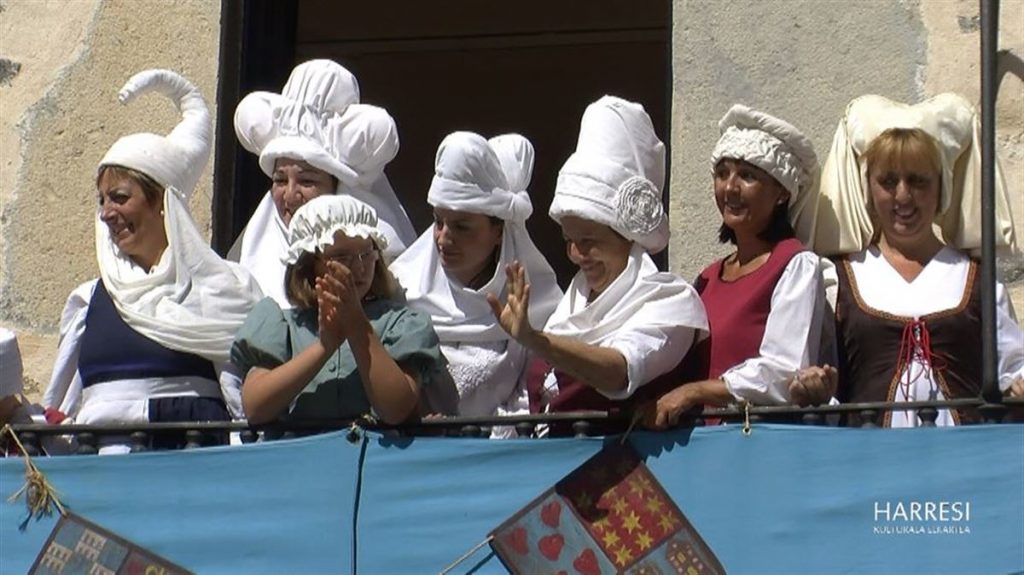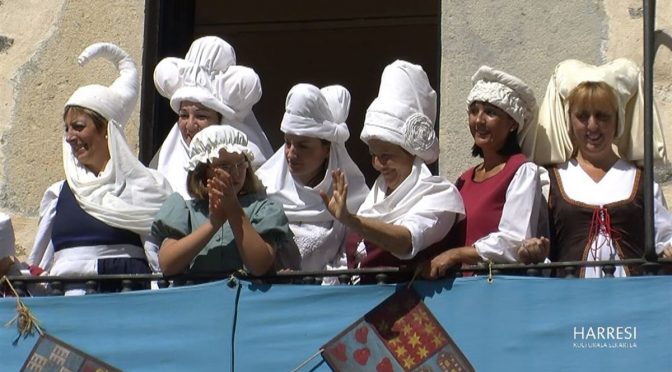One of the very distinctive elements of any Basque festival is the dancing and, in particular, the costumes the dancers wear — the white shirt and pants, adorned with a bright sash and txapela for the men and the white blouse and black vest atop a bright red skirt and black apron with leather shoes and strapping weaving up the calf topped with a white scarf for the women. These costumes are so very Basque that they are instantly recognizable. They come from a long line of clothing elements and accessories that are uniquely Basque.

- We don’t really know much about what Basques or their ancestors wore before the Romans came and wrote about them. In the first century BCE, Strabo, the ever-present Greek geographer, described the way Basques dressed at the time: the men “let their hair stream down in thick masses after the manner of women, though before going into battle they bind their hair about the forehead… All the men dress in black, for the most part in coarse cloaks, in which they sleep, on their beds of litter… But the women always go clad in long mantles and gay-coloured gowns.”
- Where the Romans had influence, however, the local dress changed. In cities like Baiona and Iruña-Veleia, people wore Roman-inspired clothing: overlapping undercloths, tunics and cloaks, made of linen and wool, whose number, quality and sumptuousness indicated the owner’s social status. On their feet they wore closed shoes and leather sandals. Short robes were relegated to the commoner population.
- This trend of layered clothing to note wealth continued and was accelerated through the Middle Ages and as the country became more urbanized. Close to the skin were the undergarments; that remained similar until around the 17th century: panties fastened with trusses on men; seams and skirts for women and, for both, a shirt and leggings up to the thigh or rolled up under the knees. Over this, both genders wore skirts tied with cords and, on top of that, sleeveless tunics often with holes for arms that reached the hip. And, finally, there were overcoats, including cloaks and capes, open or closed; the wide garnacha with short open sleeves; and the tabard with no sleeves, manners and hood.
- By the 15th century, headdress had become more and more important and very distinctive in the Basque Country. In his travels of the Iberian Peninsula with Baron Rosmithal, the Baron’s servant Schaschek noted that the headdresses of the Basque were the strangest they had seen, often shaped like chanterelles. Maidens shaved their heads, with the exception of a few locks that were kept long. Navagero later noted that these headdresses were linen, like Moorish turbans, but styled differently: “of a hood, with the tip folded, making a figure that resembles the chest, neck and beak of a crane; only that each woman makes the hood look like something different.” These headdresses became notorious, viewed by ecclesiastical authorities as “doorways for the devil,” yet another route by which women tempted men, leading to laws regulating their use and form. By the 18th century, these headdresses had all but disappeared. One of the last sightings of these headdresses occurred in 1783, during the Feast of the Assumption of Our Lady of Cenarruza, by a woman of Arbatzegi, Bizkaia.
- Roughly in the 1500s or so, style became much more influenced by outside forces and people also shifted to more individual styles. Men’s and women’s styles also became more distinct. One unique Basque stylistic feature of this time is that women always wore an apron on top of their dress. By the 18th century, the typical dress of the Pyrenees consists of men dressed in shorts plus a cape with flannel, hat and shoes with buckles; and women, with a gathered canvas headdress and overcoat, wearing, over a doublet and basquiña, a brocatel bib with a sash and apron.
- The popular costume, the one associated with the rural Basque grandparents, evolved from these elements to the form we recognize today. For women, the costume consists of a doublet, shawl or jacket matching a long and flowing skirt, colorful silk scarf at the neckline or shawl and apron, wide for work and elegant for church. Her long hair is gathered in a braid and tied with ribbons if she is a single woman and covered with a white or colored scarf if she is married. The men’s suit is made up of jackets of varied make, color and trim, and vests that, cut at the waist, form collars and lapels over linen or calico shirts, while the pants share space with the stockings, both made of canvas or cloth, with a colored sash. With the First Carlist War, the espartinak and the txapela were introduced, both becoming central elements of the popular costume. The costumes we see at Basque dances grew out of these traditional outfits.
Primary sources: Mujika Goñi, Amaia; Estornés Lasa, Bernardo. Indumentaria en Euskal Herria. Enciclopedia Auñamendi. Available at: http://aunamendi.eusko-ikaskuntza.eus/es/indumentaria-en-euskal-herria/ar-74070/; Las tocas vizcaínas, at deia.com.
Discover more from Buber's Basque Page
Subscribe to get the latest posts sent to your email.


